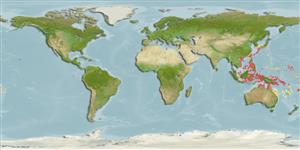>
Gobiiformes (Gobies) >
Gobiidae (Gobies) > Gobiinae
Etymology: Cryptocentrus: Greek, kryptos = hidden + Greek, kentron = sting (Ref. 45335).
More on author: Herre.
Environment: milieu / climate zone / depth range / distribution range
Ökologie
seewasser riff-verbunden; tiefenbereich 3 - 6 m (Ref. 48637). Subtropical
Western Pacific: Yaeyama Islands to southern Philippines and Palau in Micronesia.
Size / Gewicht / Alter
Maturity: Lm ? range ? - ? cm
Max length : 12.0 cm SL Männchen/unbestimmt; (Ref. 48637)
Rückenflossenstacheln (insgesamt) : 6 - 7; Rückenflossenweichstrahlen (insgesamt) : 10; Afterflossenstacheln: 1; Afterflossenweichstrahlen: 9. Characterized by pale grey body color; 6-7 diffuse greenish to grey bars on side; rear edge of gill cover with 3-4 black spots; smaller black spots scattered on head and anterior side of body; mottling dorsally on head and upper half of body; united pelvic fins, presence of frenum; longitudinal scale series 65-70; head without scales; greatest depth of body 4.5-5.0 in SL; rounded caudal fin, about equal to head length (Ref. 90102).
Found in silty sand of shallow protected reef flats and lagoons (Ref. 34765). Occurs in sheltered coastal sand flats and in estuarines (Ref. 48637).
Life cycle and mating behavior
Maturities | Fortpflanzung | Spawnings | Egg(s) | Fecundities | Larven
Myers, R.F., 1999. Micronesian reef fishes. A comprehensive guide to the coral reef fishes of Micronesia. Coral Graphics, Barrigada, Guam. 216 p. (Ref. 34765)
IUCN Rote Liste Status (Ref. 130435)
Bedrohung für Menschen
Harmless
Nutzung durch Menschen
Tools
Zusatzinformationen
Download XML
Internet Quellen
Estimates based on models
Preferred temperature (Ref.
123201): 25.3 - 29.3, mean 28.7 °C (based on 1113 cells).
Phylogenetic diversity index (Ref.
82804): PD
50 = 0.5000 [Uniqueness, from 0.5 = low to 2.0 = high].
Bayesian length-weight: a=0.00708 (0.00333 - 0.01504), b=3.09 (2.92 - 3.26), in cm total length, based on LWR estimates for this (Sub)family-body shape (Ref.
93245).
Trophic level (Ref.
69278): 3.4 ±0.4 se; based on size and trophs of closest relatives
Widerstandsfähigkeit (Ref.
120179): hoch, Verdopplung der Population dauert weniger als 15 Monate. (Preliminary K or Fecundity.).
Fishing Vulnerability (Ref.
59153): Low vulnerability (10 of 100).
